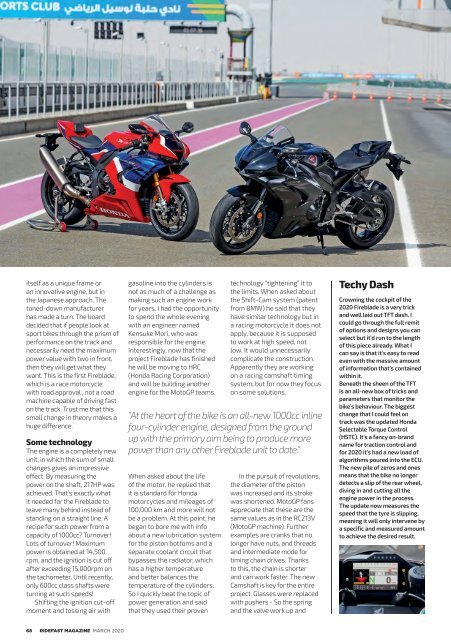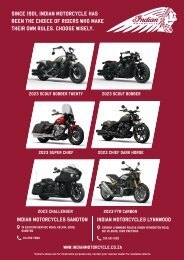You also want an ePaper? Increase the reach of your titles
YUMPU automatically turns print PDFs into web optimized ePapers that Google loves.
itself as a unique frame or<br />
an innovative engine, but in<br />
the Japanese approach. The<br />
toned-down manufacturer<br />
has made a turn. The board<br />
decided that if people look at<br />
sport bikes through the prism of<br />
performance on the track and<br />
necessarily need the maximum<br />
power value with two in front,<br />
then they will get what they<br />
want. This is the first Fireblade,<br />
which is a race motorcycle<br />
with road approval , not a road<br />
machine capable of driving fast<br />
on the track. Trust me that this<br />
small change in theory makes a<br />
huge difference.<br />
Some technology<br />
The engine is a completely new<br />
unit, in which the sum of small<br />
changes gives an impressive<br />
effect. By measuring the<br />
power on the shaft, 217HP was<br />
achieved. That’s exactly what<br />
it needed for the Fireblade to<br />
leave many behind instead of<br />
standing on a straight line. A<br />
recipe for such power from a<br />
capacity of 1000cc? Turnover!<br />
Lots of turnover! Maximum<br />
power is obtained at 14,500<br />
rpm, and the ignition is cut off<br />
after exceeding 15,000rpm on<br />
the tachometer. Until recently,<br />
only 600cc class shafts were<br />
turning at such speeds!<br />
Shifting the ignition cut-off<br />
moment and tossing air with<br />
gasoline into the cylinders is<br />
not as much of a challenge as<br />
making such an engine work<br />
for years. I had the opportunity<br />
to spend the whole evening<br />
with an engineer named<br />
Kensuke Mori, who was<br />
responsible for the engine.<br />
Interestingly, now that the<br />
project Fireblade has finished<br />
he will be moving to HRC<br />
(Honda Racing Corporation)<br />
and will be building another<br />
engine for the MotoGP teams.<br />
When asked about the life<br />
of the motor, he replied that<br />
it is standard for Honda<br />
motorcycles and mileages of<br />
100,000 km and more will not<br />
be a problem. At this point, he<br />
began to bore me with info<br />
about a new lubrication system<br />
for the piston bottoms and a<br />
separate coolant circuit that<br />
bypasses the radiator, which<br />
has a higher temperature<br />
and better balances the<br />
temperature of the cylinders.<br />
So I quickly beat the topic of<br />
power generation and said<br />
that they used their proven<br />
technology “tightening” it to<br />
the limits. When asked about<br />
the Shift-Cam system (patent<br />
from BMW) he said that they<br />
have similar technology but in<br />
a racing motorcycle it does not<br />
apply, because it is supposed<br />
to work at high speed, not<br />
low. It would unnecessarily<br />
complicate the construction.<br />
Apparently they are working<br />
on a racing camshaft timing<br />
system, but for now they focus<br />
on some solutions.<br />
“At the heart of the bike is an all-new 1000cc inline<br />
four-cylinder engine, designed from the ground<br />
up with the primary aim being to produce more<br />
power than any other Fireblade unit to date.”<br />
In the pursuit of revolutions,<br />
the diameter of the piston<br />
was increased and its stroke<br />
was shortened. MotoGP fans<br />
appreciate that these are the<br />
same values as in the RC213V<br />
(MotoGP machine). Further<br />
examples are cranks that no<br />
longer have nuts, and threads<br />
and intermediate mode for<br />
timing chain drives. Thanks<br />
to this, the chain is shorter<br />
and can work faster. The new<br />
Camshaft is key for the entire<br />
project. Glasses were replaced<br />
with pushers - So the spring<br />
and the valve work up and<br />
Techy Dash<br />
Crowning the cockpit of the<br />
<strong>2020</strong> Fireblade is a very trick<br />
and well laid out TFT dash. I<br />
could go through the full remit<br />
of options and designs you can<br />
select but it’d run to the length<br />
of this piece already. What I<br />
can say is that it’s easy to read<br />
even with the massive amount<br />
of information that’s contained<br />
within it.<br />
Beneath the sheen of the TFT<br />
is an all-new box of tricks and<br />
parameters that monitor the<br />
bike’s behaviour. The biggest<br />
change that I could feel on<br />
track was the updated Honda<br />
Selectable Torque Control<br />
(HSTC). It’s a fancy on-brand<br />
name for traction control and<br />
for <strong>2020</strong> it’s had a new load of<br />
algorithms poured into the ECU.<br />
The new pile of zeros and ones<br />
means that the bike no longer<br />
detects a slip of the rear wheel,<br />
diving in and cutting all the<br />
engine power in the process.<br />
The update now measures the<br />
speed that the tyre is slipping,<br />
meaning it will only intervene by<br />
a specific and measured amount<br />
to achieve the desired result.<br />
68 RIDEFAST MAGAZINE MARCH <strong>2020</strong>


















